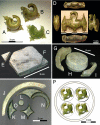Ancient jades map 3,000 years of prehistoric exchange in Southeast Asia
- PMID: 18048347
- PMCID: PMC2148369
- DOI: 10.1073/pnas.0707304104
Ancient jades map 3,000 years of prehistoric exchange in Southeast Asia
Abstract
We have used electron probe microanalysis to examine Southeast Asian nephrite (jade) artifacts, many archeologically excavated, dating from 3000 B.C. through the first millennium A.D. The research has revealed the existence of one of the most extensive sea-based trade networks of a single geological material in the prehistoric world. Green nephrite from a source in eastern Taiwan was used to make two very specific forms of ear pendant that were distributed, between 500 B.C. and 500 A.D., through the Philippines, East Malaysia, southern Vietnam, and peninsular Thailand, forming a 3,000-km-diameter halo around the southern and eastern coastlines of the South China Sea. Other Taiwan nephrite artifacts, especially beads and bracelets, were distributed earlier during Neolithic times throughout Taiwan and from Taiwan into the Philippines.
Conflict of interest statement
The authors declare no conflict of interest.
Figures




References
-
- Loofs-Wissowa HHE. J Hong Kong Archaeol Soc. 1982;IX:57–76.
-
- Reinecke A. Beiträge Allgemeinen Vergleichenden Archäol. 1996;16:1–51.
-
- Fox RB. The Tabon Caves. Manila: National Museum; 1970. pp. 126–129.
-
- Bellwood P. Prehistory of the Indo-Malaysian Archipelago. Honolulu: Univ of Hawaii Press; 1997.
-
- Higham C. Early Cultures of Mainland Southeast Asia. Bangkok: River Books; 2002.
Publication types
MeSH terms
LinkOut - more resources
Full Text Sources

